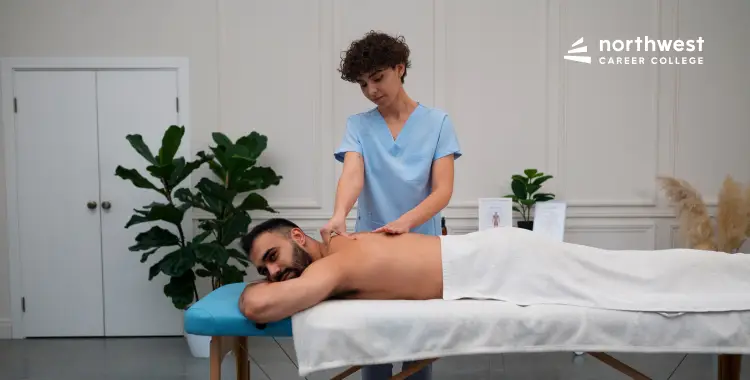The Importance of Communication in a Massage Therapy Session – Part 1
- February 28, 2025
- 4.7k views
- 5 min read
Are you currently working as a massage therapist or considering going to school for massage therapy? If so, you have likely received a massage before and are aware of how important effective communication between the therapist and client can be for the client’s comfort.
You may not have articulated it that way before (out loud or in your internal dialogue). However, if you have had more than one or two massages before, you have likely had at least one therapist who handled their communication with you well and at least one who handled their communication poorly. Therefore, on a visceral or subconscious level, you know the difference.
This multi-part article aims to unpack why these differences in communication are so significant and what the benefits are for your client. It will (hopefully) get you excited about making this a focus within your clinical practice if it’s not already or further enhancing your skills in this regard if it is.

Setting Expectations
First and foremost, effective communication between a therapist and their client begins before the massage even starts. It starts with offering a warm, welcoming greeting so the client feels at ease. Once you have done so, it sets the stage for a great session.
Discussing Health History
Massage therapists do not need to know their clients’ health history at the same level of detail as a healthcare provider. However, they still need details about their clients’ systemic medical conditions and medications to verify that no general or local contraindications for massage are present. They also need to verify this information to determine if any modifications to the session are required.
Many clients are uncomfortable sharing their health background outside a hospital or medical office setting. Therefore, it is incumbent upon the therapist to quickly build trust so that clients disclose this information willingly in the few minutes between when the client first meets them and when the massage begins.
This starts with the greeting (as described above) and is reinforced by asking the client if they have had a massage before. If so, you can gently remind them that you are collecting their health history information for their safety so you can ensure all techniques used during the session are appropriate for them. You can also remind them that client confidentiality rules apply, like HIPAA in medical settings.
If your client has not had a massage before, you can provide the same explanation, but you should also provide more time for questions since the client is less experienced with massage.
Clarifying Your Goals
Massage establishments attempt to use descriptions of the different types of massage services to “screen” and pre-identify each client’s goals for a massage therapy session. For example, Swedish and Deep Tissue massages are typically identified separately on massage “menus” and have different descriptions and pricing. This may be used to indicate a client’s goals, but it does not tell the whole story.
After you welcome your client and verify their health history (including any accommodations required for the session), you should verify your client’s goals for the session. You can reiterate your understanding of what procedure was booked (to avoid any future confusion) and their goals for the session. Some establishments collect this information on an intake form, so you can use that as a jumping-off point, but it is typically easier to just ask the client since many people do not want to spend much time notes on the form.
This part of the conversation can be straightforward if the client reports they are primarily seeking relaxation or stress reduction benefits. If they report they are seeking pain relief or improved mobility, additional questions are needed to ensure you correctly identify the source of the pain and which muscles or joints have pain or restrictions. You should still perform a clinical assessment of the area(s) they speak about, but this will direct your assessment.
At this time, you should also speak with your client about their pressure preferences (i.e., light, medium, or firm), categorically or on specific body areas, and if there are any areas they want you to spend extra time or to avoid. When a client asks for extra time on an area of the body, it is best to remind them that they will need to spend less time on other body parts during the session or to skip another area entirely and give them the chance to communicate their preferences.
Finally, while not always the primary goal, this can be the most appropriate time to verify if the patient wants any upsell services included with their treatment. For example, some massage establishments may offer additional treatments, such as hot stones or aromatherapy oils, for an extra fee.
Some clients enjoy these ancillary services but forget to ask at the time of booking, so the reminder can be appreciated. Also, it can be a win-win scenario if you are working on a commission basis.
Conclusion
Communication during massage therapy sessions is essential to clients and massage therapists feeling comfortable working together throughout the session. We spoke about a few of them in this article and will expand upon these concepts and more in Part 2 of this multi-part article. Stay tuned for more details next month!





